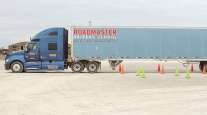Oklahoma Port Sees Increased Tonnage on Stronger Energy Sector
Shipping activities picked up in March at the Port of Muskogee in Oklahoma, which ended the first quarter of the year on a high note after struggling several months to gain momentum.
Port Director Scott Robinson credited increased tonnage shipped by barge, train and truck to a stronger energy sector, where there appears to be more optimism. Baker Hughes, which has tracked the rotary rig count as a service to the petroleum industry since 1944, reports U.S. totals have nearly doubled from a year ago to 847 on April 13.
"A lot of good things are happening," Robinson said when releasing March tonnage reports at a recent Muskogee City-County Port Authority meeting. "The energy sector is important to the success of our port, and there is a lot of optimism in the energy sector — you can see that in our tonnage."
Imported and exported goods shipped by barge in March totaled 72,070 tons. That represents an increase of 164.29% — or 44,800 tons — from the 27,269 tons shipped during the same month of 2016.
Barge tonnage for the first three months of the year totaled 164,809 tons. That exceeded the year-to-date total of 108,561 tons in 2016 by 51.81%, or 56,248 tons.
March barge cargo consisted primarily of imported commodities that included steel coils, clay, fertilizer, nepheline syenite, molasses and rebar, which arrived on 44 barges. Exports consisted entirely of calcine coke, which left the port on four barges.
March rail tonnage at the Port of Muskogee totaled 16,399 tons, a 15.89% increase — or 2,248 tons — from the 14,151 tons shipped by rail during the same period a year ago. Year-to-date, rail cargo totaled 60,399 tons, up 4.79% from the 57,636 tons reported during the first quarter of the 2016 calendar year.
Imported commodities that arrived in March by rail consisted primarily of pipe, metal, glass cullet, asphalt and 11 other commodities, all of which arrived on 159 cars. Rail exports, which left the port on 30 cars, included petroleum coke, fertilizer and pipe.
Truck cargo tracked in March totaled 29,276 tons, which was up 4.69% — 1,313 tons — from the 27,964 tons reported for the same month in 2016. The year-to-date total of 126,383 tons represents a 47.71% increase from the 85,560 tons reported during the first quarter of 2016.
Asphalt made up about half of all imported commodities that arrived in March at the port on 558 trucks. Metal, asphalt and pipe topped the list of five commodities that were exported in March from the port by truck.
Robinson said he and Industrial Development Director Marie Synar have been working to "identify supply chains for existing local and regional industries that might present opportunities for the port's terminal operator." Those commodities, he said, can be received by barge, stored at the port, and then shipped when needed to area manufacturers.
Distributed by Tribune Content Agency, LLC



